 By Staff By Staff
May 5, 2015
MILTON, ON
Crawford Lake Conservation Area is featuring the artwork and writings of talented Tuscarora artist Raymond R. Skye. The exhibit, titled Haudenosaunee Clans…Extended Families of the Iroquois opens today, Tuesday, May 5 and will be on display 10 a.m. to 4 p.m. daily until June 30, 2015 in the newly built Deer Clan Longhouse.
 Raymond Skye The exhibit will engage guests in a rich experience combining art, video, and hands-on elements to build understanding of the heritage and clans of the Haudenosaunee people. Imagine standing in a modern longhouse, listening to the lyrical poetry of the book The Great Law Kayaneren’ko:wa as written and narrated in English by Metis author David Bouchard, and in Mohawk by Six Nations of the Grand River community member, Frank Miller. The powerful words are accompanied by the visual feast of Raymond’s artworks.
Tim Johnson, Associate Director for Museum Programs, National Museum of the American Indian, Smithsonian Institution, Washington and New York had this to say about Skyes’s work:
“The value of Raymond Skye’s artistry is immeasurable. In an information age where ideas and influences are transferred around the globe at the speed of light, it is vitally important that distinct cultures and nations have in place powerful and sustainable mechanisms for their preservation. As an earnest and life-long student and teacher of Haudenosaunee culture, Ray’s contributions to his heritage are numerous and exceptional.
His art documents the primary narratives of Haudenosaunee origin, emergence, and history, enveloping substance within imagery that informs cultural awareness and inspires the people to forever remember. The presence of an artist like Raymond Skye in our community and nation is not only invaluable, it is essential!”
—

 By Staff By Staff
May 5, 2015
BURLINGTON, ON
On May 12, 1989, Mayor Roly Bird signed a twinning agreement with Mayor Kurihara of Itabashi, Japan.
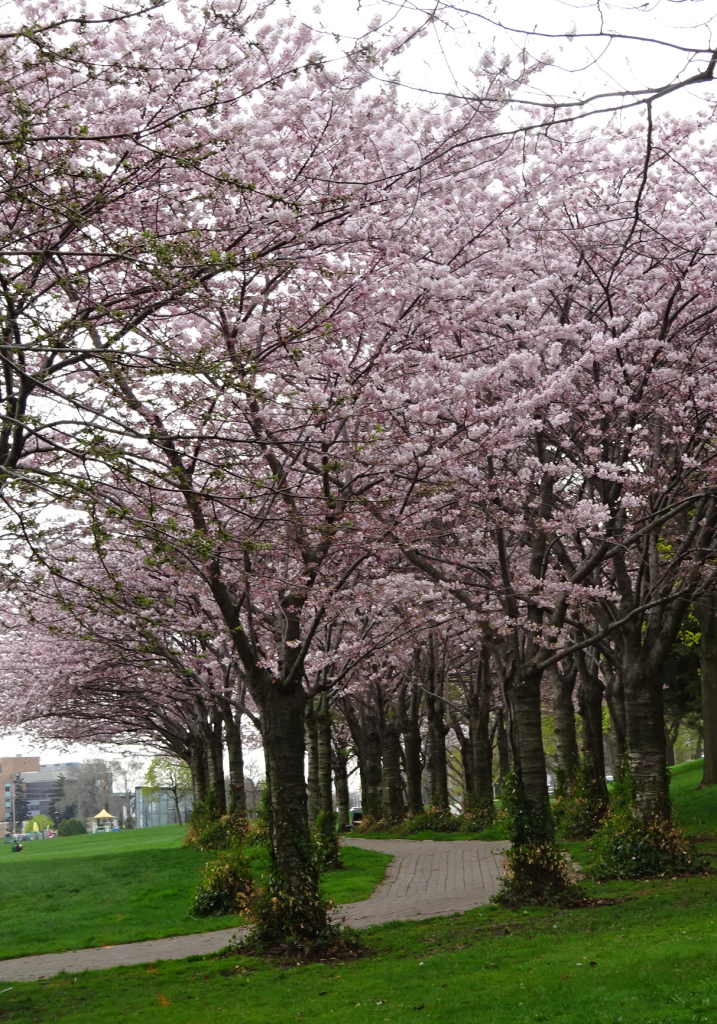 Many Burlington visitors see the rows of cherry blossom trees as a bridal arch. The trees were a gift from Japan. As a result of that agreement two rows of Sakura Cherry Blossom trees have grown in Spencer Smith Park.
On Saturday, May 9, 2015, 1 to 2:30 p.m. at the Art Gallery of Burlington, Lakeshore Room the public is invited to the Sakura Cherry Blossom Festival.
The Japanese look forward to the annual bloom of the sakura tree as it is the premier sign of spring in Japan and blossom viewing parties are organized by companies, departments, neighborhoods and families.
Highlights:
Japanese taiko drum demonstration, with Burlington’s own Do Kon Daiko drum group
Koto performance and hands on demo by members of Kiri Koto Ensemble
Japanese dancing performed by Suzuran Odori Dancers
Martial arts displays from Burlington’s Shudokan Family Karate.
A presentation outlining the history of the sakura, both in Japan and here in Burlington
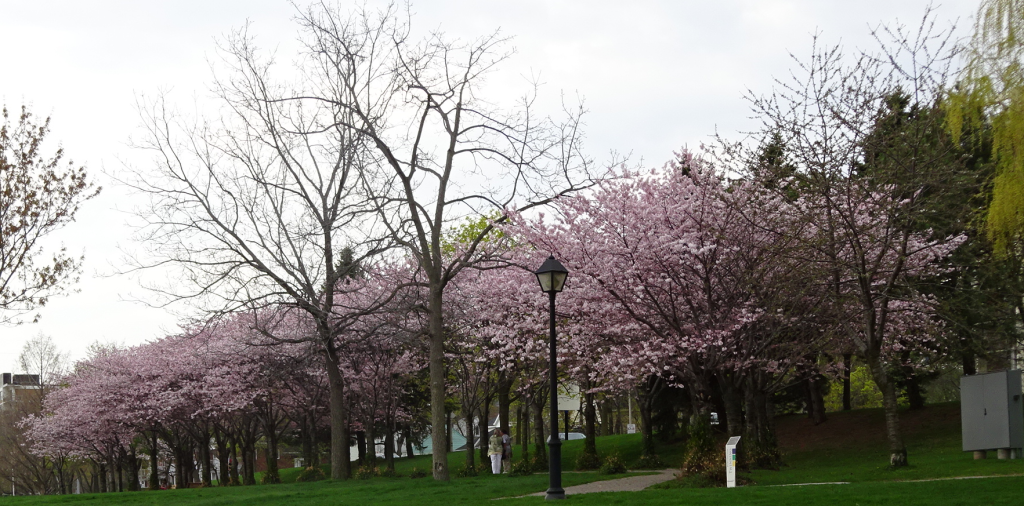 Each year, usually in May, the trees blossom adding to the splendor of |Spencer Smith Park Burlington’s sakura trees are located in Spencer Smith Park, near the gazebo and the pier

 By Staff By Staff
May 4, 2015
BURLINGTON, ON
Art – mural art to be specific – is going totally local. If you don’t reside in Burlington – you don’t get considered.
The City’s Public Art program has been massaging this idea for a while now – calling it the Burlington Mural Project, it is designed to tell local stories using local artists.
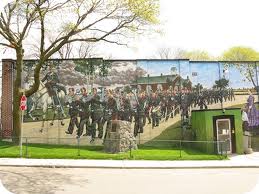 This mural is on a store wall in Scarborough. Intended as an annual program, it will commission small to medium-scale murals throughout the city. These commissions are open exclusively to Burlington, Ontario artists. There will be free professional development opportunities offered to assist artists with the application process and project development.
Six murals (one mural per ward) will be commissioned in Year 1 of the program. Commissions will range in value from $2,500 – $12,000 depending on the scale and complexity of the project.
The locations for the murals were selected through a public process. Residents were asked to submit mural locations and themes (via an online and in-person survey). 333 location suggestions were received, resulting in 114 unique locations. Locations that are not selected in Year 1 will remain on file for subsequent years of the program.
Applications can be found on the Calls for Artists page
The public art program hosted a ‘Murals 101’ workshop on April 25, 2015, which featured Karin Eaton, Executive Director of Mural Routes and mural artist Allan Bender in a lively discussion about contemporary mural making.
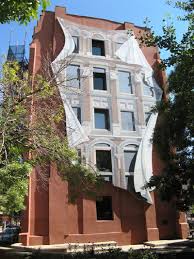 This mural is at the rear of the Flat Iron building on Front Street in downtown Toronto They discussed a variety of mural techniques and materials using real life case studies. A copy of the powerpoint presentation and additional notes are available on the Public Art website.
The applications are due on June 8th
Application Review Sessions will take place on May 25-26, for those who need help preparing an application to the Burlington Mural Program? The Public Art Managers are hosting a free application review session on May 25-26. Book a one-on-one session (20-30 minutes) to review a draft of your application and receive constructive feedback.
These sessions are open to all artists who are actively preparing an application to the Burlington Mural Program. Attendance will be voluntary and appointments must be booked in advance. To book an appointment please contact: Kim Selman, kim@cobaltconnects.ca or 905-548-0111
There are a wide variety of resources related to mural production, installation and conservation online. The Public Art program managers have complied a list of useful resources that may be helpful when preparing an application.
The project is being managed by Cobalt Connects – they are looking at a possible ten year program but add that it will probably be more like five years.
Five murals in each ward of the city might be a little over the top’
It will be interesting to see what comes in in the way of ideas.

Halton’s Emergency responders kick off Emergency Preparedness Week at First Responder’s Day celebration
 By Staff By Staff
May 2, 2015
BURLINGTON, ON
The only time an emergency matters – is when that emergency is on your doorstep – and far too often that is just a little too late.
Being prepared – without getting bent out of shape is what the Region is promoting with the emergency responders events planned for the celebration of First Responder’s Day and kick off the 2015 Emergency Preparedness (EP) Week -May 3 to 9.
This year’s Emergency Preparedness Week theme is: I am Ready. We are Ready.
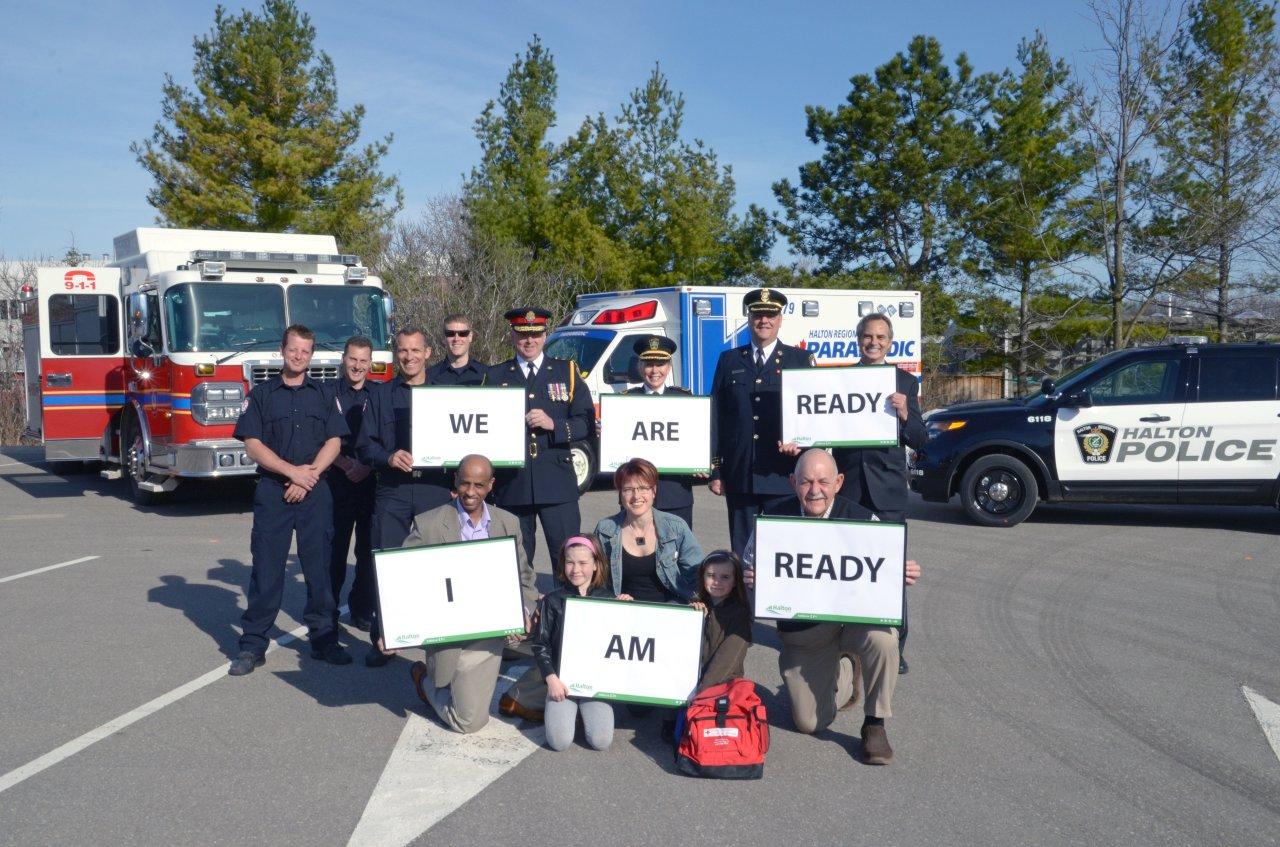 Back row (left to right): Firefighter Kevin Dudek, Captain Trevor Edmond, Firefighter Mano Kruger, Firefighter Alex Shipley, Halton Regional Police Chief Stephen Tanner, Halton Paramedic Services Deputy Chief Christine Barber, Oakville Fire Department Deputy Chief Brian Durdin, Regional Chair, Gary Carr Front Row (from left to right): Zerezghi Haile, Raine Montgomery (age 9), Andrea Montgomery, Jayden Montgomery (age 7), Don Goshgarian “Community safety remains a top priority for Halton Region and I would like thank all of Halton’s first responders for their ongoing efforts and for helping to keep Halton the safest community in Canada,” said Regional Chair, Gary Carr.
“This year’s Emergency Preparedness Week theme serves as a great reminder that emergency preparedness is everyone’s responsibility. I ask all our residents to reach out to others who may be vulnerable or unable to support themselves during an emergency, including family, friends and neighbours.”
Reaching out to others means knowing your neighbours and letting them know about you.
The Province of Ontario designated May 1 as First Responders’ Day to celebrate the sacrifices and hard work of First Responders who have devoted their lives to public service. Emergency Preparedness Week is a national awareness initiative that encourages residents to take steps to be prepared for a range of emergencies. It aims to raise awareness of the three key steps to being prepared for an emergency:
Step 1: Know the hazards and risks in your area;
Step 2: Make a plan to protect your family in the event of an emergency; and
Step 3: Get an Emergency Go-Kit so that you and your family are self-sufficient for at least 72 hours.
Do you think that you could survive for 72 hours in the home you live in now? Do you have what you need? Think what would happen if you were suddenly told that you could not leave your home for the next three days due to some catastrophe?
For more information on instructions and what should be included in the emergency kits you should have. You do have one – don’t you?
In photo
Back row (left to right): Firefighter Kevin Dudek, Captain Trevor Edmond, Firefighter Mano Kruger, Firefighter Alex Shipley, Halton Regional Police Chief Stephen Tanner, Halton Paramedic Services Deputy Chief Christine Barber, Oakville Fire Department Deputy Chief Brian Durdin, Regional Chair, Gary Carr
Front Row (from left to right): Zerezghi Haile, Raine Montgomery (age 9), Andrea Montgomery, Jayden Montgomery (age 7), Don Goshgarian

 By Staff By Staff
May 2, 2015
BURLINGTON, ON
It will be the weekend when the gardeners go nut2 – the 23rd and 24th of May. They will be flooding the gardening stores and working away in their gardens – and if there is a parent that is a gardener the kids are going to have to fend for themselves.
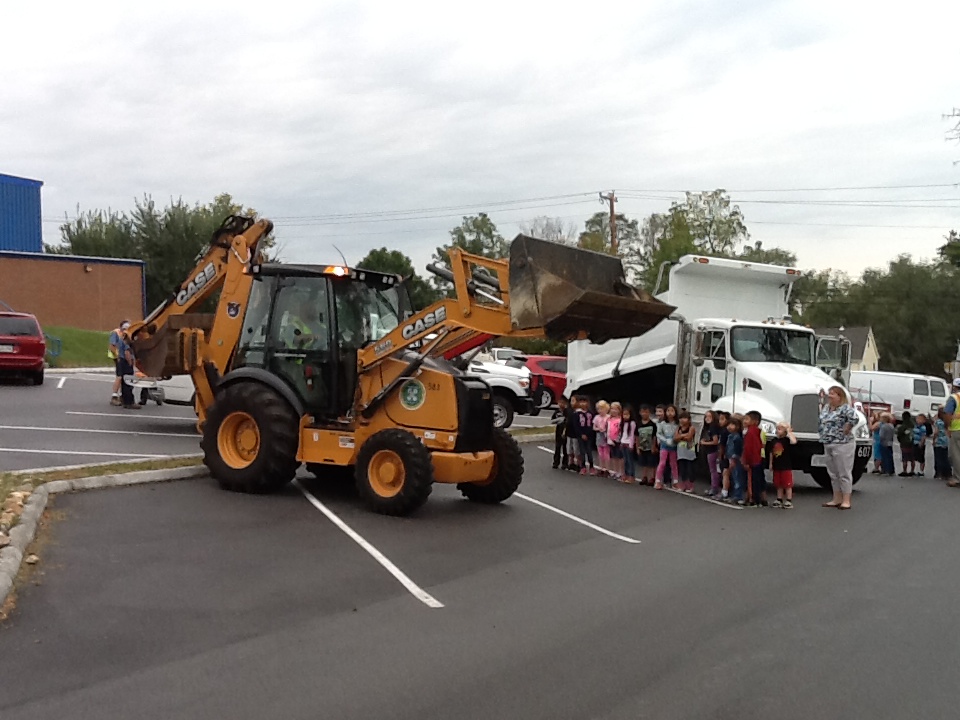 The kids like getting up close to this kind of heavy equipment. It’s an inexpensive day out for a family. How about getting out and Touching a-Truck? Each year the city holds a celebration for National Public Works Week – public works people are the men and women who fix the pot holes, shovel the snow and clean the catch basins – the unsung heroes who keep the wheels of the city going around.
 Anyone who has nothing better to do is invited to the city’s roads and park maintenance facility to get an up-close look at a variety of city vehicles. Anyone who has nothing better to do is invited to the city’s roads and park maintenance facility to get an up-close look at a variety of city vehicles.
At the Touch-a-Truck event, families are invited to:
– Get close to city vehicles, including a fire truck, street sweeper, and
snowplow
– Sit in a backhoe simulator to experience what it’s like to be a driver
– Enjoy a free barbeque (11:30 a.m. to 1:30 p.m.)
So come on out to this year’s Touch-a-Truck event and get a unique look into our city vehicles. Saturday,
May 23, join the City of Burlington for the third annual Touch a truck event
11:00 AM – 02:00 PM
Location:
Burlington Roads and Parks Maintenance Facility
3330 Harvester Road
Burlington, Ontario, L7N 3M8

 By Ray Rivers By Ray Rivers
May 1, 2015
BURLINGTON, ON
Was Dr. Benjamin Spock the father of us all? His ‘Common Sense Book of Baby and Child Care,’ published simultaneously with the birth of the first postwar baby boomers, set the path for child development for my generation and, at least, for the one that followed. Spock held that sex-education, including its spiritual aspects, should be part of a broad health and moral education, from kindergarten through the end of high school, ideally carried out harmoniously by parents and teachers.
 Isn’t that exactly what the updated provincial sex-ed curriculum is trying to do? Spock has his detractors but there have been scores of pedagogical disciples who mostly followed in his footsteps and adhered to his general principles. And after a couple of generations it is hard to criticize what we have grown to know and appreciate. Isn’t that exactly what the updated provincial sex-ed curriculum is trying to do? Spock has his detractors but there have been scores of pedagogical disciples who mostly followed in his footsteps and adhered to his general principles. And after a couple of generations it is hard to criticize what we have grown to know and appreciate.
Of course the ‘spare-the-rod’ clan, and those newer-Canadians who were steeped in a traditional authoritarian family cult, object to what they see as the self-actualizing child. They consider sex-education, any of it, an insult and a case of the state interfering in their personal lives. Some hold, and others worry, that what they call ‘juvenile permissiveness’ will lead to a more violent and sexually perverted society, even if the numbers don’t support that linkage.
But the elephant-in-the-room is whether sex-education encourages sex? Spock and his disciples argue that the more children learn about sexuality from authoritative sources (parents, teachers, accurate literature), the less they will feel compelled to find out for themselves. We’re talking about where they get their facts (friends, violent movies, the internet, sexting or worse).
G. W. Bush ushered in an era in US education where sex-education became nothing more than preaching abstinence. A decade later, the results have been shown to be dismal, at best. In the US there are 750,000 teen pregnancies each year, 82% unintended, and almost 60% percent of these result in children bearing children. The rest of the teen pregnancies are either aborted or were miscarried. And then there are the sexually transmitted diseases.
Obama overturned Bush’s failed initiative, and now the US only funds programs which have been proven effective at reducing teen pregnancy, delaying sexual activity, or increasing contraceptive use. Abstinence, no doubt, remains a topic of discussion within these comprehensive sex-education programs, but their primary purpose is to prevent negative sexual health outcomes.
Ontario’s new sex-education curriculum is to be implemented starting this September, which will land it just in time for the expected federal election this autumn. Some pundits have speculated that this might be a factor among voters who are unable to distinguish between federal and provincial policies and responsibilities.
 For many parents talking about sex is just not something they can do – a classroom can provide the information young people need – we cheat them if we fail to inform them. I recall canvassing, when I ran provincially in Burlington, and being accosted by voters angry over the implementation of the federal long-gun registry at that time. So that should be a consideration for the Liberal leaders. Though, the push-back on the curriculum is coming mainly from the religious-right, who identify mainly with the Conservative party anyway. And then there are the new Canadians who often find common ground with the Tories on this issue.
Of course if the parents could all be trusted to objectively teach their kids the essentials about sex, this might not even be an issue. But they don’t, do they? How many parents take the time or have the courage to discuss sex in the context of a modern diverse society – and beyond the elementary birds and bees?
Parents have no prepared curriculum and generally no training. And even if they did, the topic is likely way too personal for most of them to handle it in an objective and balanced manner. Kids find their way through the internet, on the streets or in somebody’s recreation room when the parents are still at work.
As for those angry, complaining parents who think they know better than professional educators and psychologists, the apple usually falls near the tree. Tolerance and respect for others is as important in sexuality as the lessons on anatomy, I would think – but what do I know.
I’m an economist, went to a one-room school, was raised on a farm and I got my education out behind the barn.
Background links:
Notable Quotes Dr. Spock How Dr. Spock Destroyed America
Effectiveness of Sex-Ed Programs Teen Sources of Sex Information Anti-Sex Ed Coalition
Wynne and the Federal Election Conservative Protests Canadian Pregnancies
 Ray Rivers writes weekly on both federal and provincial politics, applying his more than 25 years as a federal bureaucrat to his thinking. Rivers was a candidate for provincial office in Burlington where he ran as a Liberal against Cam Jackson in 1995, the year Mike Harris and the Common Sense Revolution swept the province. Ray Rivers writes weekly on both federal and provincial politics, applying his more than 25 years as a federal bureaucrat to his thinking. Rivers was a candidate for provincial office in Burlington where he ran as a Liberal against Cam Jackson in 1995, the year Mike Harris and the Common Sense Revolution swept the province.

 By Walter Byj By Walter Byj
May 1, 2015
BURLINGTON, ON
While some parts of the Halton region are experiencing high growth spurts, others have remained stable. In one part of the Region, schools need to be built to accommodate the growing population while others areas face shrinking school populations. This is the case for a number of areas in established geographical areas of Burlington.
For elementary schools, Burlington has 10 areas that are identified by an ERA -Elementary Review Area – (remember the acronym – it gets used frequently) number and capacity is measured by OTG – on the ground – (same with this one) seats that do not include portables. Each of these areas has their unique situations.
ERA 100 (Aldershot and Tyandaga) is in western Burlington and is represented by Aldershot Elementary, Glenview King’s Road and Maplehurst, the utilization of the totality of the schools is in the 63% to 68% range and will remain so for the next 10 years. Aldershot Elementary is currently at 46% and will continue at that rate for the next 10 years while King’s Road will decline from 66% in 2014 to 52% by 2024.Maplehurst is currently at 71% while Glenview stands at 93% for the current year.
 The enrolment should be somewhat consistent for the next 10 years with a potential uptick for Glenview pending the development of the northern Aldershot community north of the QEW. The enrolment should be somewhat consistent for the next 10 years with a potential uptick for Glenview pending the development of the northern Aldershot community north of the QEW.
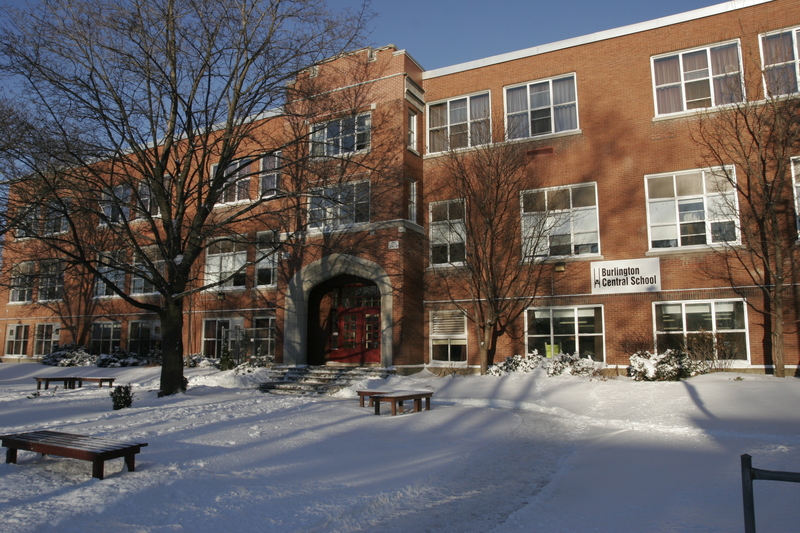 Central High School enrollment is expected to increase ERA 101(Downtown) covers the downtown core of Burlington and includes Burlington Central, Central Lakeshore and Tom Thomson schools The overall utilization rate is currently 91% and should remain in that area for the next 10 years. The number is highly influenced by Tom Thomson which in reality is overcapacity as it has 10 portables (mainly due to French Immersion) and will continue their use for the next 10 years. Burlington Central is at 65% currently and is projected to increase to 73% by 2024. Central is at 84% and projected to fall to 72% by 2024. Lakeshore should grow from its current 63% to 73% in 2024.
 Tecumseh is in an area where several schools have gone beyond their built capacity. ERA 102 (Roseland and Shoreacres) is bound by Guelph Line to the west, Appleby to the east with the QEW to the north and the lake to the south. It includes John Tuck, Pauline Johnson, Ryerson and Tecumseh. This area has a utilization rate of 88% which will drop to 77% in the following 10 years. Both Tuck (134%) and Pauline Johnson (117%) are over overcapacity and currently rely on portables to accommodate students. By 2024, Tuck is projected at 107% and Pauline Johnson at 110%. Ryerson currently is at 49% and is expected to grow to 53% by 2024. Much of this growth will come from phasing in the gifted program from Charles R. Beaudoin. Tecumseh will drop from the current 57% capacity to 51% by 2024.
It should be noted that there are no French immersion classes in this area as the students attend either Tom Thomson or Pineland.
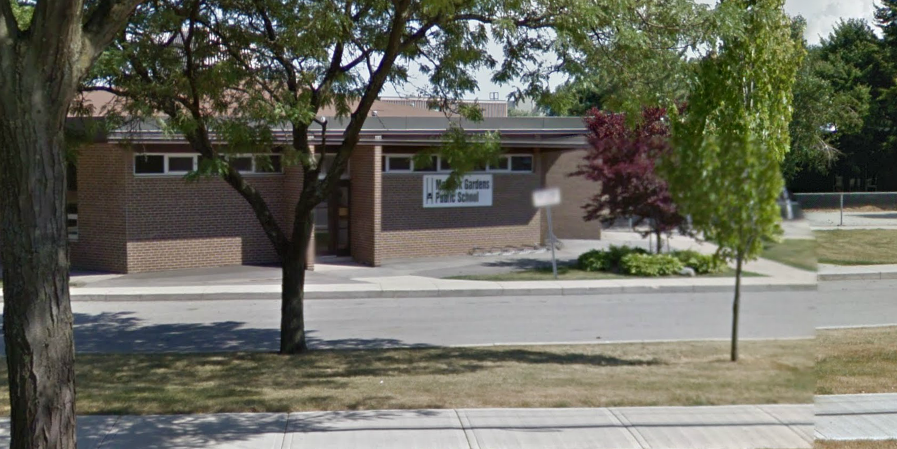 Enrollment at Mohawk is expected to decline going forward. ERA 103 (Appleby) covers the area between Appleby line and Burloak with the QEW to the north and the lake at the south. There are three schools in this area, Frontenac, Mohawk Gardens and Pineland and has an overall utilization rate of 78% which will remain steady to 2024. Mohawk has a rate of 71% but this is expected to drop to 63% by 2024. Frontenac, at 56% is expected to grow to 76% by 2024. This will mainly be due to Pineland becoming a French Immersion school with the English stream moving in some part to Frontenac or Mohawk. Pineland, at 111% is well over capacity and has six portable to cover the overflow. As the transition to a French Immersion school only continues, the utilization rate will slowly decrease to 88% by 2024.
ERA 104 & 105 (Brant Hills, Headon and Tyandaga) is bounded by Dundas to the north and Upper Middle to the south with Walker’s Line being the eastern boundary. The four schools in this area are Brant Hills, Bruce T. Lindley, CH Norton and Paul A. Fisher and have a current utilization rate of 87% which will decline to 76% by 2024. Brant Hills has the lowest utilization rate at 59% and is projected to drop to 57% in 2024. Bruce T. Lindley is healthy at 93% and will remain stable for the next 10 years and is projected to be 89% in 2024. C.H. Norton is healthy at 91% but will slide to 73% in 2024, while Paul A. Fisher is currently at and will remain in the low 60 percentile for the next 10 years.
ERA 106 (Mountainview and Palmer) holds four schools with highway 407 on the west, Walkers on the east with Upper Middle on the north and the QEW to the south. The utilization rate for this area is 87% and should fall to 76% by 2024. Although each school currently has a strong utilization number, they will each experience decreasing numbers in the upcoming years as follows;
Clarksdale – 94% to 77% (2024)
Dr. Charles Best – 92% to 84% (2024)
Rolling Meadows – 78% to 68% (2024)
Sir E. Macmillan – 96% to 77% (2024)
ERA 107 (Millcroft) has two schools, (Charles R. Beaudoin and Florence Meares) and is between Walkers Line and Appleby and Dundas to the north and the QEW to the south. This area is currently at 105%, but is expected to drop to 86% by 2024. Charle R. Deaudoin will drop from its current 114% to 80% in 2024 while Florence Meares will drop from 95% to 91% during the same time period.
ERA 108 (Orchard) contains three schools (Alexander’s, John William Boich and Orchard Park) and lies between Appleby and Bronte and Dundas to the north and the QEW to the south. This area is currently at 115% of OTG and will slowly decline to 93% by 2024. Both J.W. Boich and Orchard Park are over utilized and will continue until 2024. Alexanders, which is currently at 119% is expected to drop to 70% by 2024.
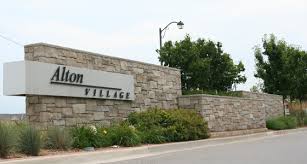 The public school in Alton is already beyond capacity; Hayden High School is now operating with all the high school grades. ERA 109 (Alton) has one school, Alton Village, and is bound by the 407 to the north, Dundas to the south and Walkers to the west and Tremaine to the east. This school is over utilized at 124% and this could rise to 153% by 2024.
ERA 110 (Rural Burlington) has one school also, Kilbride, and has a current OTG of 77% which will drop to 73% by 2024.
These numbers reflect a bleak future for some of the elementary schools in Burlington. Forecasting is not an exact science, but unless Burlington has a major change in its population makeup Burlington might be looking at some consolidation.

 By Staff By Staff
April 30, 2015
BURLINGTON, ON
The Halton Regional Police Child Abuse and Sexual Assault Bureau have completed an investigation into allegations of historical sexual assault against a now retired school teacher.
It is alleged that the accused was teaching at Fairview Public School in the City of Burlington over the years 1969-1975 and sexually assaulted a male student during that time.
Charged:
David COTTERELL, 67 years, of West Grey, Ontario has been charged with Indecent Assault on a Male, scheduled to appear in court on May 20, 2015.
Police encourage anyone with information related to this investigation to contact Detective Constable Wendy Clayton at the Halton Regional Police, CASA Bureau – 905 825 4747 Ext 8970 or wendy.clayton@haltonpolice.ca

 By Pepper Parr By Pepper Parr
April 30, 2015
BURLINGTON, ON
For an event that is critical to how Burlington decides to grow and of concern to a lot of people who aren’t all that excited about the idea of intensification – Mayor Goldring had some hurdles to get over.
Fortunately he had some good news – Burlington is going to handle the intensification that has to take place very well.
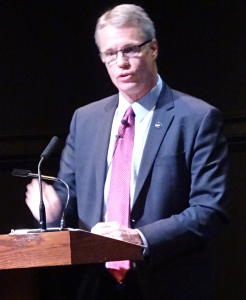 Mayor Rick Goldring speaking to a full house at the Performing |Arts Centre about intensification. The speech was the first Mayor Goldring has given to a large public audience since his re-election and he took the podium at the Performing Arts Centre as the first speaker in his Inspire events. The Inspire events were begun during the Mayor’s first term and have proven to be one of the brightest things he has done. Taking the podium himself put him in the same league as some of the best thinkers in the province.
The public didn’t hear anything astonishingly new during the presentation – basically it was told that intensification is going to take place because it is something we have to do and that Burlington’s traditional neighbourhoods are not going to see significant change.
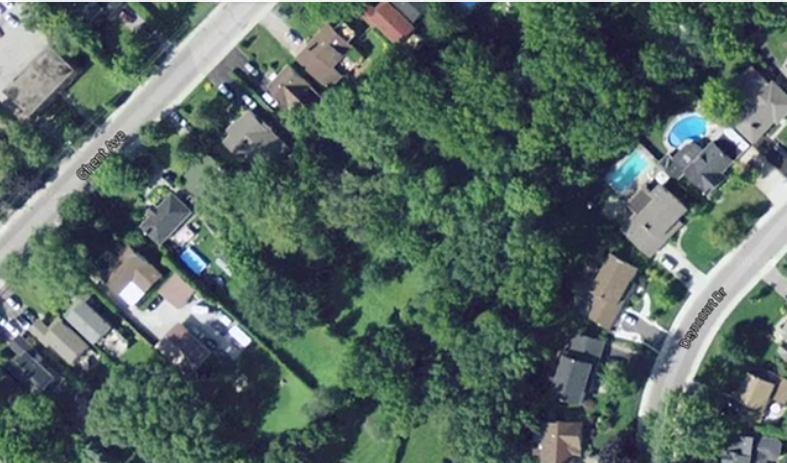 The bulk of that magnificent tree canopy in the center of this project on |Ghent east of Brant met with chain saws – it didn’t have to happen. That statement doesn’t square all that well with the development nearing the final stage of construction on Ghent Avenue where 8 houses were taken down and 58 homes built. But let us not quibble over details. The properties did have a hold designation and they were going to be assembled – there was the chance to do something magnificent but the developer chose to cut down more than 100 trees and build back to back townhouses. That was what they determined the market wanted.
The Mayor explained that the federal government handles immigration and determines how many people are going to be taken in. While the federal government can’t tell the 250,000 people who arrive on our doorsteps where they have to go but it does know that they head for the major urban centres. Burlington is within in the Greater Toronto Hamilton Area – we call it the Golden Horseshoe and they come here by the thousands.
The province told the Region how much its population had to grow; the Region took that number and began to allocate it amongst Burlington, Oakville, Milton and Halton Hills.
Burlington’s population now is at about 178,000 – we have to grow to 193,000 by 2031 – the information available at this time suggests Burlington is on track to reach its targets – the suggestion is that we are a little bit ahead.
Mayor Goldring talked about the opportunity along Plains Road and Fairview. He acknowledged that Aldershot residents are concerned about how growth in their community is likely to change their life styles; he pointed to the very significant potential for better use of land along Fairview.
He added to that the eventual residential development at Eagle Heights at the western end of Aldershot and the interesting way development is taking place in mid-town.
The city has come to realize as well that there is a lot of room for intensification within both the Burlington and Mapleview Malls where some medium rise buildings could be placed with commercial at grade and three to six floors of residential above.
 Intensification that complies with the existing Official Plan and the zoning on the property will begun construction early next Spring on Brant Street just south of Ghent The addition of well over 100 residential units to the Brant Square Plaza is a fine example of intensification that will add value to a community. In this instance it will anchor the new northern boundary of the Burlington Downtown Business Association.
At some point someone is going to do something with the Lakeside Plaza in eastern Burlington.
There was potential along Tremaine Road north of Dundas and some room left in the Alton community.
Mayor Goldring did say that we would not be expanding the urban boundary – that is developing north of the Dundas – 407 border – the statement didn’t come across as a ringing statement – it sounded just a little on the limp side. We will watch the Cogeco broadcast and pay closer attention to the strength of his comment.
The reality is that Burlington cannot on its own change the urban boundary – we would have to convince the Region to let us do that and then we would have to work within a provincial policy and the Niagara Escarpment rules and regulations.
However, during a drive around the Burlington properties that could be developed with then Executive Director of the Economic Development Corporation Kyle Benham, he made the statement that the land on the north side of the 407 was just too good from a commercial exposure point of view to be used for just growing hay. This city knows what developers have been able to pull off in the past.
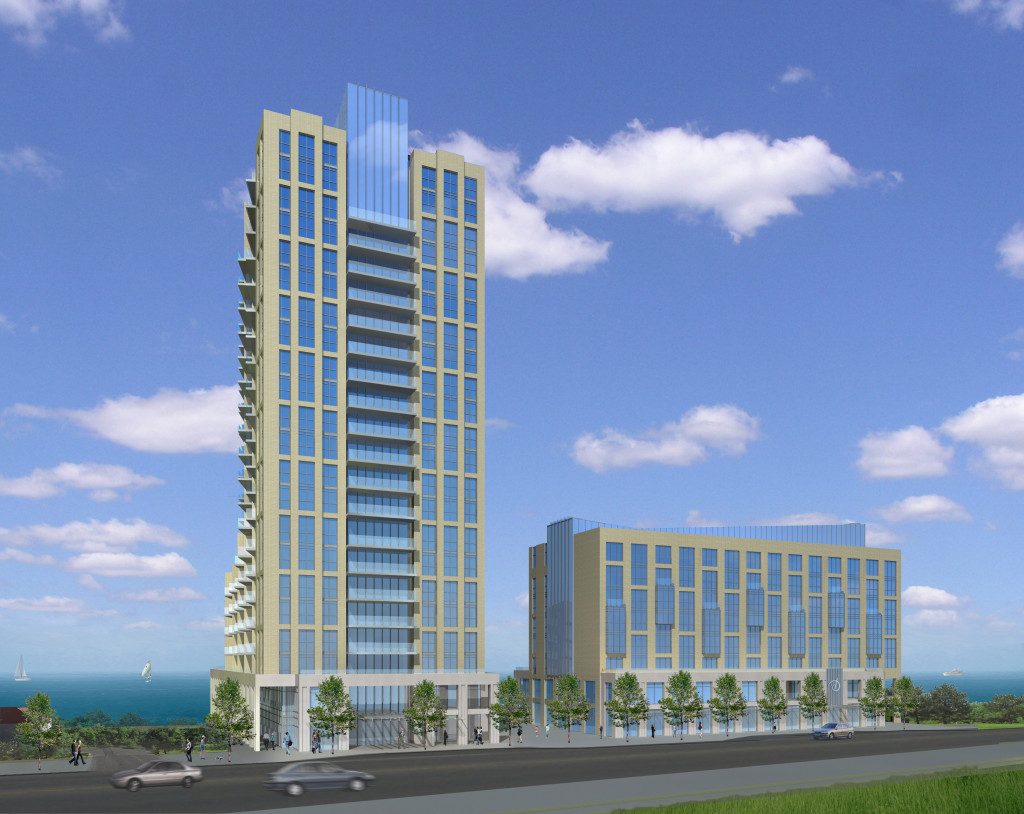 The height of the Bridgewater condominium at the edge of the Lake is going to stun the public as the watch it rise storey after storey. It may well prove to be the justification for an even higher building yards away. That point will get driven home when the Bridgewater condominium begins to rise twenty stories on the edge of Lake Ontario yards from the downtown core.
The Mayor told the audience that the average sale price for a single dwelling was $565,000 – which is great for all those seniors who are approaching the point in their lives when they will want to sell and move into a dwelling that doesn’t require the effort to cut the grass or blow the snow away; a place they can lock up and head to Florida for a couple of months in the winter.
The flip side of that of course is finding younger families who can afford to pay $565,000 for a home.
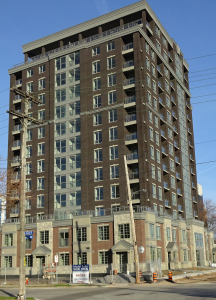 The Brock condominium was opposed by the community – it was approved and is now selling – it fits into the community – but that wasn’t the way the public saw it two years ago. The Mayor pointed out that there have been developments the public didn’t like but were approved nevertheless. He mentioned the Strata project on Maple. He could have mentioned he Brock Project as well when he explained that these projects were opposed by the pubkic but they were built and and it didn’t take long for people to move in and like the buildings.
Burlingtonians tend to not like anything that is new or different – they want the city to remain the way it was when they were raising thi r families; those people are growing older and the houses they were raised in are growing older as well.
 The proposed Maranatha retirement home on New Street, approved by the city and now before the OMB is an example of the kind of growth Mayor Goldring believes the city should be looking at. Goldring took the position that the Maranantha project proposed for New Street, now before the OMB, is something people in the immediate community will want to live in – he said at the time that he thought some of the people opposed to the project now will eventually be residents in that building.
The phrase the Mayor said he heard again and again during the election was that everyone loved the city just as it is – one of the things they didn’t want more of was congestion.
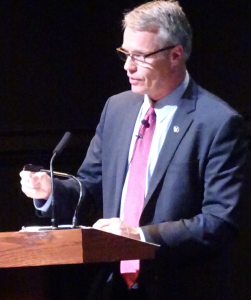 Rick Goldring – Mayor of Burlington explaining the why of justification to an audience of close to 200. Mayor Goldring was the 17th Inspire speaker – did he Inspire? Well he didn’t get a standing ovation – it was more than just polite applause. Goldring speaks better in front of an audience than he does at Council. There he tends to be stilted, a little awkward, reads from a script and is certainly not relaxed.
There is a quote: “You can take the boy out of the country but you can’t take the country out of the boy.” It will be interesting to listen to Rick Goldring if there is every a day when he leans on a podium and talks from his heart about his vision and lets us see if the boy has outgrown at least some of the country that is in him.
The future concern for Burlington is how many people are we going to have to grow by between 2031 and 2041 – and what kind of people are we going to grow by. The Regions has been told that it has to grow by 220,000 people between 2031 and 2041 – how much of that growth is Burlington going to have to absorb?
Milton has been growing at an exceptionally rapid pace – can it be expected to take more.
GO train service is going to upgrade to every 15 minutes in the not too distant future and our infrastructure appears to be capable of handling a significant amount of growth.
The Region just might be asking Burlington to swallow a large chunk of that 220,000 projected population growth – Rick Goldring didn’t mention that earlier this week.
He will not be Mayor when that shovel full of if hits the fan.

 By Pepper Parr By Pepper Parr
April 29, 2015
BURLINGTON, ON
The creation of the strategic Plan for the next three years began Tuesday morning at the LaSalle Pavilion. Council and senior city staff met as a Committee of the Whole and while these occasions are public meetings – there wasn’t a member of the pure public in the room.
The Gazette was the only media in the room as well. There were two representatives from community Development Halton taking part in the presentation of a social profile of Burlington.
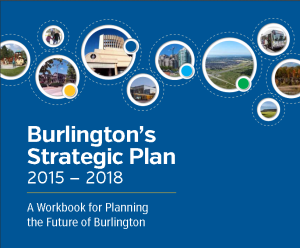 What became clear quite early is that the development of the Strategic Plan and the completion of the Official Plan are being done hand in hand – each is going to inform the other. What became clear quite early is that the development of the Strategic Plan and the completion of the Official Plan are being done hand in hand – each is going to inform the other.
Who lives in Burlington; who is going to live in Burlington and where will they want to live? These were the prime questions put before the meeting of about 40 people.
Community Development Halton put together a very detailed profile of who we are and what we are worth. This data was set out as the base upon which both the Official Plan and the Strategic Plan are going to be created.
None of this is going to happen in 90 days – the public may not see a completed Strategic Plan until sometime in October.
There will be more public involvement in the 2015 Strategic Plan than there was in the 2011 Plan. The city created a workbook that was made available to anyone who asked. At one point there were just 35 completed but that number “zoomed up to 90.
Knowing what is probably going to be needed in the way of housing tells the planners what kind of development they want to encourage – and developments do get encouraged.
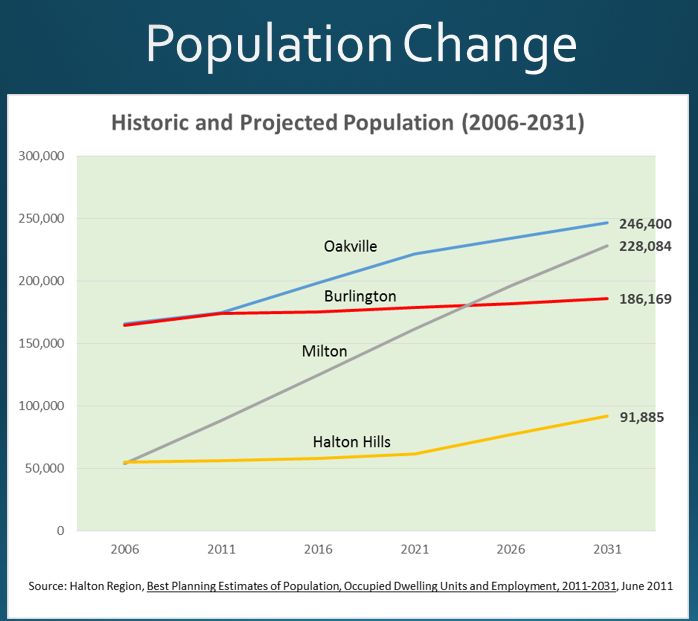 Burlington population growth has flat lined, Milton is sky rocketing and Oakville is pulling ahead. These projections have significant political and economic implications – the Region may well decide that more of the population coming into the Region should land in Burlington. A presentation of 24 slides told the story – the first was a look at the historic population of the municipalities in the Region
There was a time said Mayor Goldring when Burlington was bigger than Oakville however since then Burlington’s growth has basically flat lined while Milton has grown very rapidly.
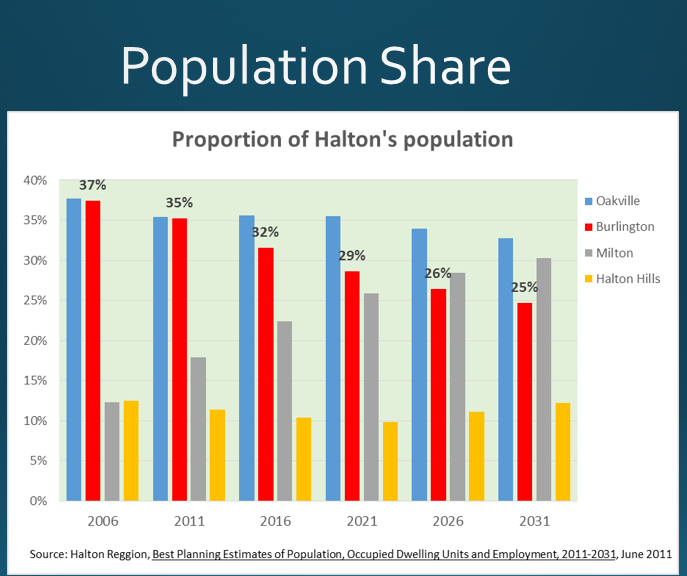 Our portion of the Region’s population is shrinking while that of Milton has skyrocketed. When the 2016 census data is available the Region is required to look at where people live and re-balance the political representation at the Region. Burlington’s political clout will be based on the number of Regional Councillors. Right now every member of city council is also a regional Councillor. The make up of out city council could undergo a significant change.clout The way population was shared within the Region was interesting.
The change in where people lived is shown in #3. Some communities remained stable while others experienced significant growth. The red dot in the upper half is the creation of the community of Alton.
A large part of the discussion around population was the provincial requirement that population grow in the Region. The province requires Halton to grow and the Region determines where that population was going to go in each municipality.
Each municipality then determines where it is going to put the population growth in its municipality.
One point that got made several times was that Burlington’s growth would be done by intensification and that the older traditional communities would not undergo any intensification.
Mayor Goldring talks about the city being built out – Ward 2 Councillor Meed Ward says the city has hundreds of acres of land. One would expect they would both have access to the same data – apparently not.
Every conversation about population growth refers to the seniors and how that demographic is growing. The Molinaro Paradign project that will have five towers next to the GO station on Fairview is not going to house than many seniors – but the mental focus is still on the seniors.
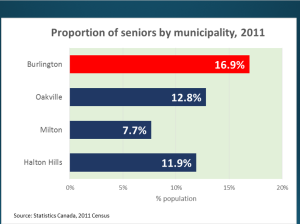 Burlington clearly has the largest percentage of seniors and at the same time we have some of the highest rents and the lowest vacancies. The need for some deep understanding of the demographics of the community became obvious. Here is what we know: The senior population increased by 17% to 29,720 between 2006 and 2011. The seniors represent 16.9 % of the population seniors over 80 have increased by 21% More than 62% of older seniors are female and 1 in 4 seniors live alone.
What kind of money do these people have? The median income for seniors is $33,280 and the median income for everyone is $40,180
In 2010, 64% of female seniors had incomes of less than $35,000; of the male population that percentage was 38.
The number of children living at home had some surprises – the definition of children for this exercise included people more than 25 years of age.
 There were more female seniors with incomes of less than $35,000 than there were male seniors. Income was defined as that which is shown on tax returns. With older children living with their parents the number of people in a household by themselves was close to astonishing.
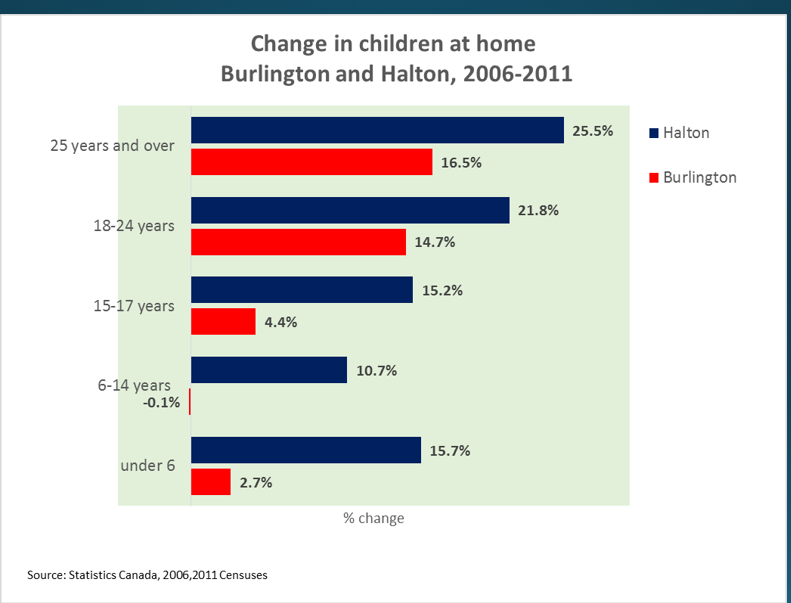 The number of people over 25 living with their parents is a little on the alarming side. The discussion on this data centered around whether or not this was going to continue or if it is a short term situation.
Some of the growth in Burlington is going to come through immigration. The Community Development Halton Development identified the sources of that immigration – it amounts to less than 2000 people
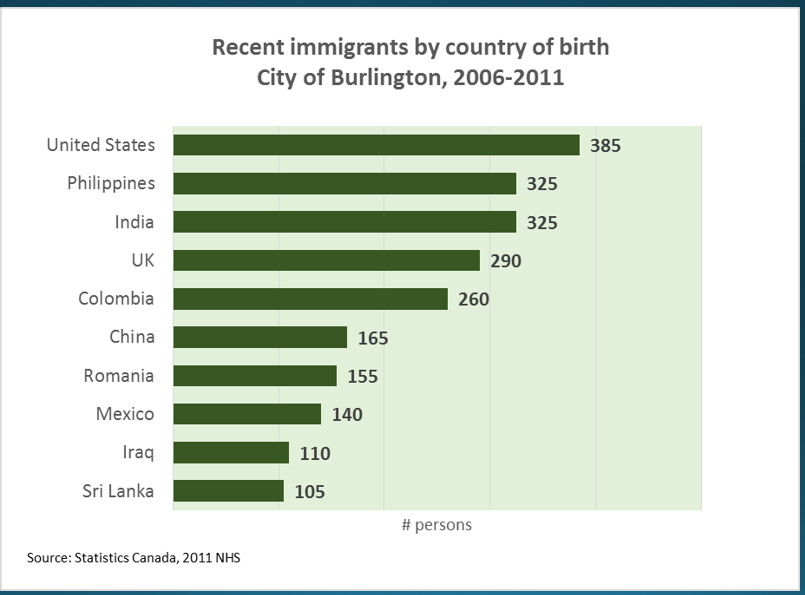 Immigration into the Region by country of birth. The total is in the 2000 range which the bulk coming from the United States How is income distributed in Burlington? Everyone has always said Burlington is a wealthy city – the data supports that belief.
On the flip side of the very wealthy is identifying the poor; 9.5% of the population in Burlington is poor.
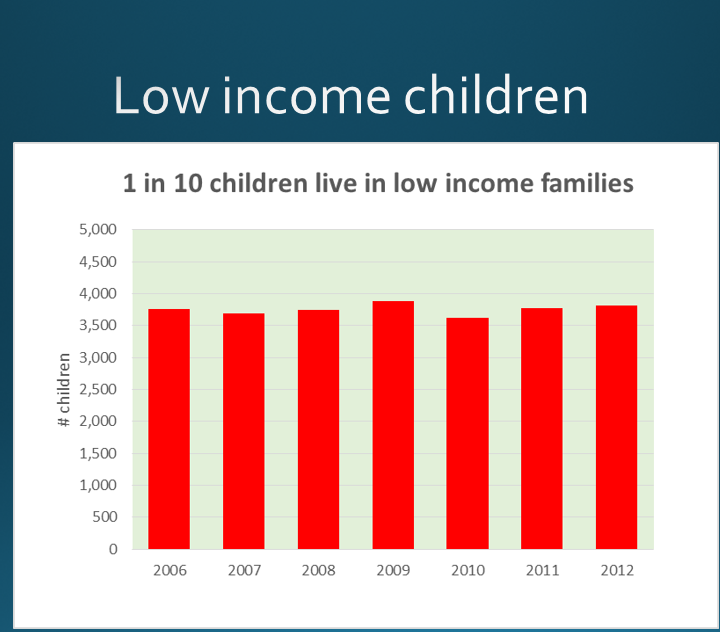 It would be useful to understand why the number of low income children has remained close to static even though population has grown. The number of low income children has been pretty consistent the past seven years – why? That question did not come up. We seem to have accepted that we just have them.
The prevalence of low income people is also interesting. It shot up during the recession in 2009 but never really came down to pre-recession levels.
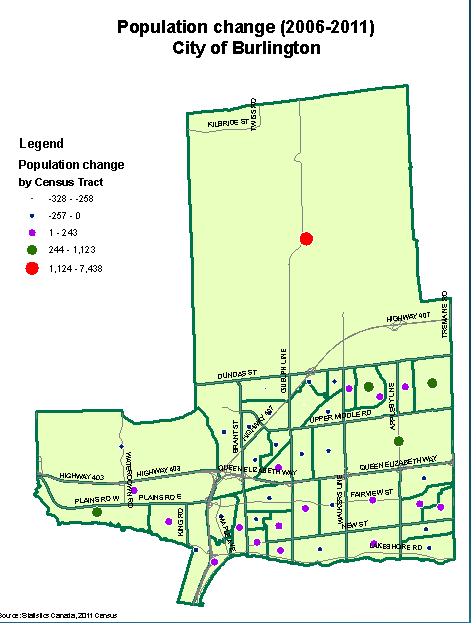 The numbers beside the dots indicates the level of growth. That big red dot reflects the growth in Alton. Where does that low income population live? In Burlington we can’t say below the tracks – there are tracks all over the place – but there are clearly identified pockets of low income families
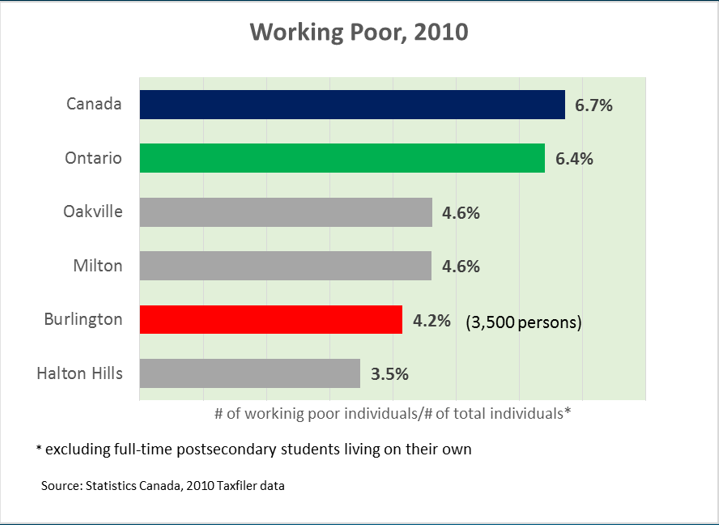 There is a link between the working poor and the amount of affordable housing in the city. That link is not fully understood by the community. 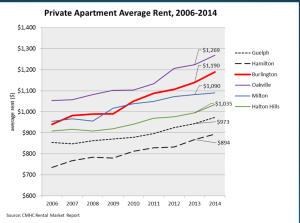 Rents are experiencing excellent growth – great if you are a landlord. Many of the new developments are being marketed as condominiums that are bought by investors and rented. 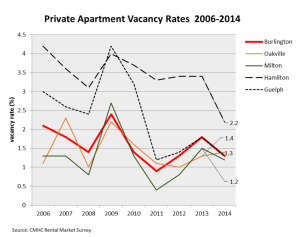 Apartment vacancy rates are very tight throughout the Region and is Hamilton as well. Burlington’s working poor as a percentage of the population compared with other jurisdictions – Burlington is low on that scale – at 4.2% – which is 3,500 persons.
Owning an apartment building is a solid investment in the Region. Rents have experienced a solid climb – well in excess of inflation. The difference between Burlington and Hamilton explains why people will drive to get to Burlington every work day.
The vacancy rate is very tight throughout the Region and in Hamilton as well. A 3% vacancy rate is seen as a healthy, balanced market.
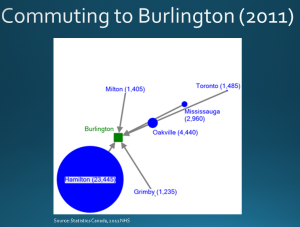 The number of people who commute TO Burlington from Hamilton is very high. A deeper understanding of the dynamics behind these commutes is probably needed. The number of trips made by people in Burlington to their jobs outside Burlington and the number of people who drive to Burlington to work is really interesting.
What isn’t clear is the why of those trips. Do people drive to Burlington from Hamilton because rents are cheaper in Hamilton.
Do people drive from Burlington to other places because that is where the jobs are?
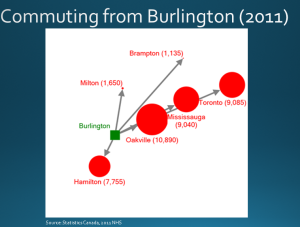 The traffic out of the city is due in some degree to employment opportunities. The city has yet to find the formula that will attract employers and reduce the commutes out of the city.
The belief is that people who work outside the city are less likely to be engaged with activities in the city – which was put out as part of the reason voter turnout is so low – it has been a consistent mid thirty percent range.
And yet the percentage of people who volunteer is very high in Halton – at the 50% level. The population is relatively generous – a smidgen lower than the Ontario average and lower than Oakville
Understanding the shifts that take place in population: immigrants coming into the country; seniors moving out of large homes into smaller townhouses or condos; young people renting their first apartment and the working poor looking for affordable housing is the work of demographers – Burlington doesn’t have one.
Windsor, a city with a population of 600,000 has six demographers on staff which prompted planner Bruce Krushelnicki to extrapolate that and come to the conclusion that Burlington should have two – Krushelnicki would settle for one.
A solid understanding of what Burlington has in the way of population, how that population is likely to shift and what future population might be are the building blocks on which the Official Plan and the Strategic Plan will be built.
That process has now begun – by the end of the year city council and the public will have had the time needed to ensure that everyone at least understands what those plans are – getting them to agree is another matter.

 By Pepper Parr By Pepper Parr
April 27, 2015
BURLINGTON, ON
Culture in Burlington took another step forward last week when a Culture Days information session took place at the Art Gallery of Burlington.
 Local artists were able to set up a booth in Civic Square at the 2014 Culture Days – most reported they did very well at raising their profiles.
It was a small crowd but several of the people who play major roles in how culture is marketed and delivered in this city were in the room
There is a non-profit organization that maintains a web site with everything anyone would want to know about cultural events in the province. Culture Days raises the awareness, accessibility, participation and engagement of Canadians in the arts and cultural life of their communities.
To make it really work the Culture Days organization say again and again – ya gotta register – and the earlier the better.
Register an event is what makes an event work. It is not the simplest thing to do. McLeod wasn’t able top get the computer she was using to project the process onto a screen but the Gazette went on line and gave it a whirl – and it does work.
There are four basic criteria to Culture Days activities:
1. Your activity is free to the public
All activities registered as part of Culture Days are free; that is, they cannot be ticketed or occur in a space that charges admission. If you have already planned a mix of free and ticketed programs, register your free activities with Culture Days, and simply let the public know that you have other activities available as well. Fundraisers or sales can happen in proximity to your free event as long as it does not overshadow or restrict/prevent access to free activities. Note: asking for voluntary donations or placing a donation box near the entrance is not the same as requiring donations.
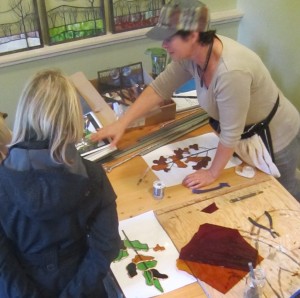 Teresa Seaton, a stained glass artist has been a prime mover behind the annual Art in Action tour – and is now part of the newly formed Arts and Culture Collective. 2. The activity takes place during the Culture Days weekend: September 25, 26 and/or 27, 2015 Activities registered as part of Culture Days take place during this year’s Culture Days weekend, but you do not need to have three days of activities or activities that last all day. Even a single one-hour participatory event scheduled during the Culture Days weekend qualifies. If your organization already offers arts learning or outreach activities, simply schedule one of your regular events during Culture Days.
3. The activity is participatory
All Culture Days activities are participatory in nature. This means that your activity involves some kind of hands-on aspect or offer the public “backstage”/behind-the-scenes access to see how you do what you do. Invite the public to go beyond a typical audience experience and instead play a part in the creative process. For instance, if you are in a choir, rather than stage a performance, you might offer a workshop on how to sing or harmonize; if you own or operate a dance studio, you might offer a dance class; if you are involved in a community radio station, you could offer a guided tour of your studio. Engagement and participation is key, regardless of the activity. Don’t forget that fun counts too! People love to do what they normally don’t have a chance to experience. Refer to the activity types in the upcoming section for more participation ideas.
4. The activity is registered at culturedays.ca
When you register your activity online, you officially become part of Culture Days and benefit from the national promotional campaign that directs the public to the website to discover activities in their community. Registering online also gives you the chance to be included in the national Public Relations and Marketing campaign. You can also sign up to get regular e-newsletters with valuable advice and news about Culture Days.
Activity Types and Categories
There are five basic participatory activity types that can be registered as part of Culture Days, encompassing a wide range of artistic and cultural categories/disciplines.
1. hands-on activity: create, help make or try doing something yourself
2. behind-the-scenes: see inside artistic spaces and get a peek at creativity in action (indoors/outdoors)
3. excursion: tour of more than one location (eg. art gallery crawl)
4. discussion: artist talks, panels, round-tables and other cultural conversations where you can learn and discuss
5. collective creation: contribute to a collaborative act or work or art
The criteria and the regulations have that distinct stamp of a bureaucrat on them – but the process does work.
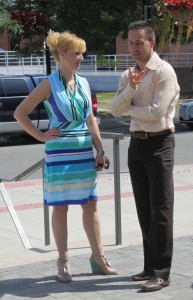 The city’s cultural manager guided Burlington’s participation in the 2014 Culture Days – Angela Papariza talks to Trevor Copp who took a plea to city council for a better cultural environment in the city. On the last Friday of September (September 25, 26 and 27, 2015) many municipalities in Ontario celebrate Culture with a three day event. Burlington has done this for a number of years and will be doing so again this September.
Promotion is critical according the Catherine McLeod who runs the Ontario arm of Culture Days
Why Register an Activity? From highlighting your community, raising your profile and meeting new audiences, to networking and connecting with like-minded citizens, the reasons are multiple!
 Some of the most exciting quilting ever done was on display at the Art Gallery of Burlington last year. It will be interesting to see how the Art Gallery chooses to participate in 2105 Highlight the Cultural Vibrancy of Your Community
Every corner of this country is full of creativity, arts and culture. By participating in Culture Days, you help your fellow citizens become aware of the many unique opportunities available to them and encourage participation in arts and cultural activities in your own backyard. You draw attention to the different cultures and heritages that contribute to the development and vitality of your community.
You cast a spotlight on the cultural organizations and individual artists in their midst.
From children’s choirs, “stitch and bitch” groups and performing arts organizations to art colleges, museums and design firms, there are myriad perspectives, experiences, disciplines and techniques to share and discover. Working together, Culture Days participants showcase the vibrancy of local arts and culture, and encourage everyone to discover something new, something different, and to re-connect with their own creativity and community.
Arts and culture initiatives and industries not only make a vital contribution to our dynamic economy but, crucially to the social development of our neighbhourhoods, regions and country, promoting life-long learning, creative thinking, resiliency, appreciation of diversity, compassion and so much more.
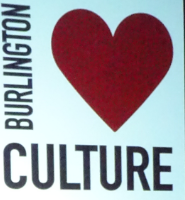 Spread the word. Arts and culture are important. Spread the word. Arts and culture are important.
Make Worthwhile Connections, Meet New Supporters & Audiences
A significant amount of Culture Days activity organizers share space with other organizers during the weekend, often collaborating with someone or organizations with which they had not previously worked. Whether it is to create a hub of diverse activities in one area to attract visitors, or as an excuse to finally contact someone you’ve been meaning to connect with, Culture Days is the perfect opportunity to meet other creative people in your area, share resources, form new alliances that will last year-round, and meet new potential supporters and audience members.
Collaborations can also inspire unique cross-pollination among creative practices, connecting across sectors, cultures and generations.
Moreover, your participation in Culture Days can be the catalyst to create a legacy of strong connections between citizens, artists, cultural workers and their communities.
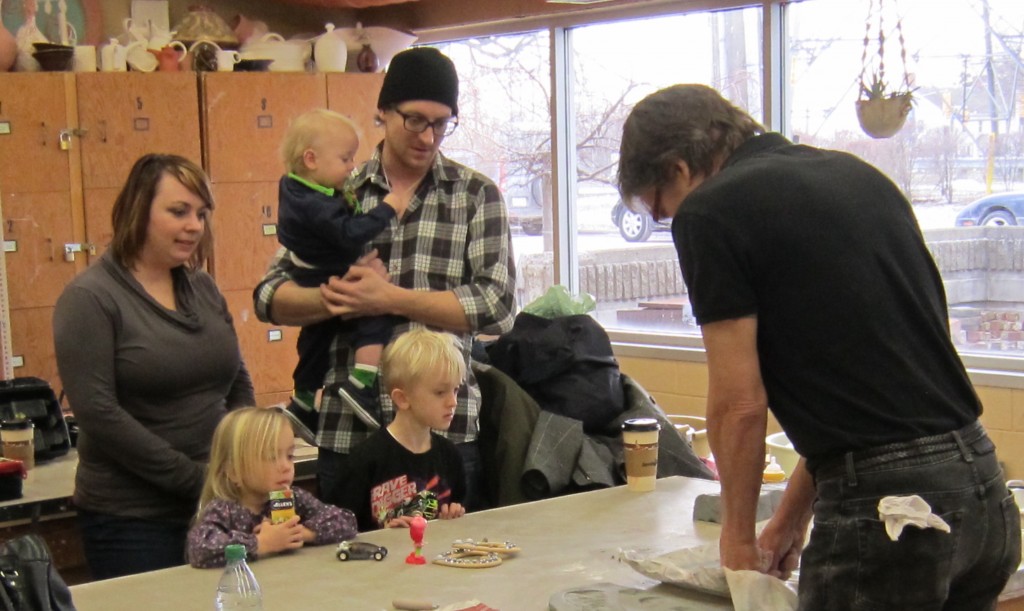 During the creation of the Spiral Stella the public provided artifacts that were bronzed and made a part of the sculpture that stands outside the Performing Arts Centre. Here children watch in amazement at how the moulds are made. Develop Your Skills
Culture Days offers a fantastic opportunity to sharpen your promotional and organizational skills.
By taking advantage of the free tips and tools offered on the website, you can make the most of your Culture Days experience and apply everything that you have learned or improved upon year-round.
Whether it is leveraging social media for the first time as a promotional tool, organizing as a community, or connecting with people as passionate as you are, the vast and varied network of collaborators that makes up the Culture Days initiative is the perfect support system.
Learning works best when you have people to share it with, so don’t hesitate to get out there and put it all into practice, and be sure to not be humble about your successes!
Raise Your Profile
Culture Days offers helpful tips and tools to conduct your own promotion and media relations. It is a great opportunity to be featured in your local paper, association newsletters, or arts blogs, to name a few. Don’t hesitate to tell everyone about your unique activity.
In addition to being included in the national marketing and communications campaign, you might also take part in local or regional marketing initiatives. By pointing the general public to culturedays.ca where your activity is registered, people in your community and beyond your usual circles will learn about you and your activity.
Benefit from your participation by collecting contact information, business cards and comments from your visitors. This is a chance to build your email list and collect glowing testimonials for your next brochure or website update. Just by sharing your passion and talents, you can recruit new members, clients or audience members on the spot.
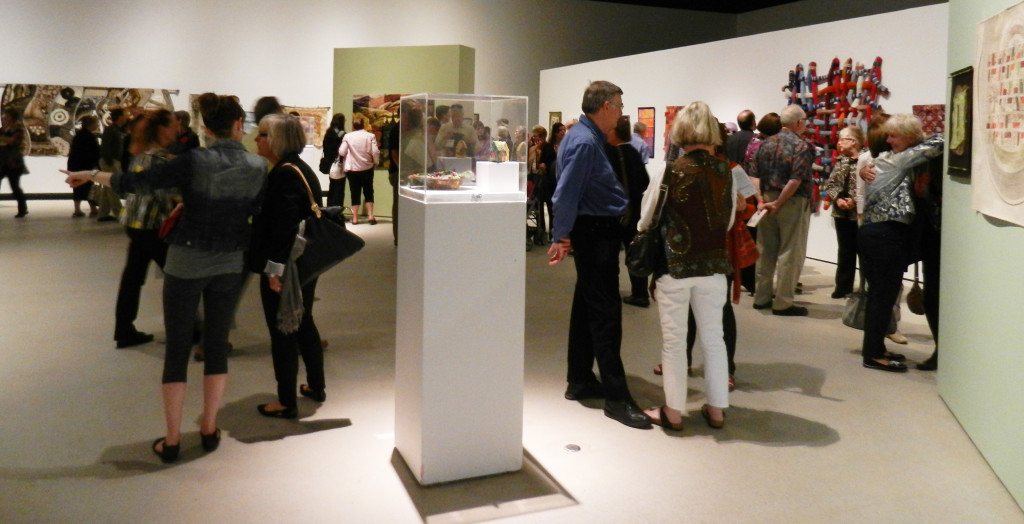 Making culture the focus of conversation is what the Culture Days committee feels will raise the profile of the arts in a community. Unite To Make Arts and Culture The Topic of Conversation
Culture Days is the largest-ever collective public participation campaign undertaken by the arts and cultural community in this country. Last year, artists, cultural organizations, diverse groups and local organizers in nearly 800 communities registered some 7,500 events. The marketing and media campaign generated impressions in the hundreds of millions.
In the three years since its inception, one in three Canadians reported being aware of Culture Days – that’s more than 11 million people!
By participating, you promote and reveal the creativity of our citizens, creators, organizations, and communities through a vast Canada-wide marketing and public awareness campaign. Whether you create a new program or already have a relevant interactive activity planned, everything included in the Culture Days weekend pushes arts and culture into the limelight.
It all happens September 25, 26 and 27, 2015 – what artists do between now and then will determine just how successful the day is. Wish for sunshine!

 By Staff By Staff
April 27, 2015
BURLINGTON, ON
Getting people to tell you what they think before decisions are made seems to be harder than listening to people who are unhappy with decisions that have been made.
City Council is about to begin the process of setting out the Strategic Plan they will use as a guide for the decisions they make for the next three years.
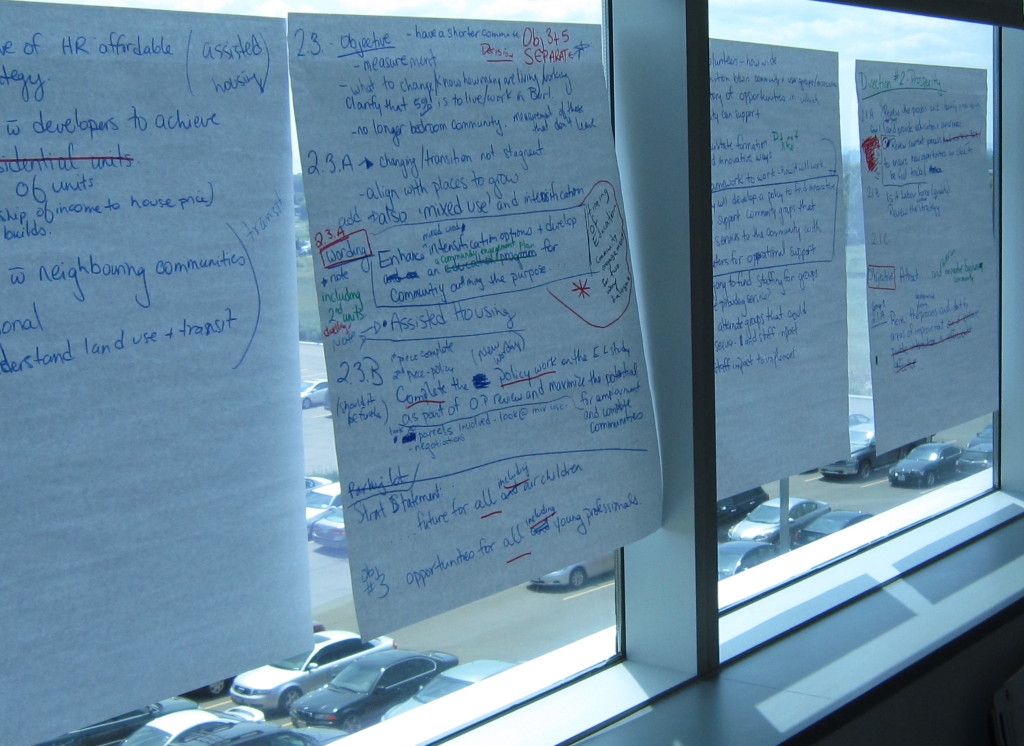 Ideas and concepts were written up on sheets of paper and put up wherever there was space. It all got debated and boiled down to the Strategic Plan the city is now working with – that plan is to be reviewed and revised now. The Strategic Plan created in 2011 was an excellent document. It did have some limitations but given that prior to 2011 the city tended to publish a booklet with a lot of nice picture and precious little in the way of content. 2011 was great.
The Plan adopted by Council was a long time in coming – staff and council took eleven half days to discuss and debate what the priorities should be – what they wanted to focus on and achieve in the term they were getting into.
They settled on three Strategic Directions:
Vibrant Neighbourhoods
Prosperity
Excellence in Government
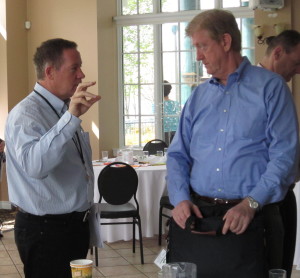 The body language tells it all – there was some,e vigorous debate during the creation of the best Strategic Plan the city has had in some time. Here Frank McKeown, current Executive Director of the Burlington Economic Development Corporation, the Mayor’s Chief of Staff at the time and Paul Sharman city Councillor and a member of the Board of the BEDC Whenever a staff report was prepared for Council the writers of the report were expected to show how the recommendation was related to those three directions
As part of public engagement, which hasn’t been all that good so far, the city is asking the public to download a copy of a Workbook that has been put together for any individual who wants to express an opinion. The Workbook is an opportunity to provide input into planning Burlington’s future.
The deadline for submissions has been extended until end of day May 4, 2015.
In its media release the city said: “To help set priorities, each Burlington City Council creates a strategic plan to match with the four-year term of council. The 2015-18 City of Burlington strategic plan will result in changes to the 2011-14 strategic plan, based on community feedback and changing needs.”
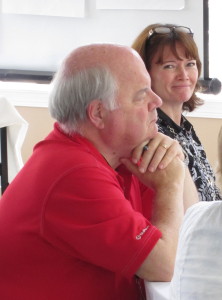 The Strategic Plan was facilitated by Georgina Black; they couldn’t have done the job they did without her. Prior to extending the deadline for comment the city had received less than 50 responses.
The workbook is available online or in hard copy and can be mailed on request. Strategic plan facilitators are on standby to help groups complete the workbook. Please contact strategicplan@burlington.ca, call 905-335-7600, ext 7378, or visit www.burlington.ca/strategicplan for details.

 By Staff By Staff
April 24, 2015
BURLINGTON, ON
You make hay when the sun shines – that’s what the farmers will tell you.
 Mayor Goldring clearly knows when he is on a roll – the interest in what he has to say about intensification has filled all the seats at the Performing Arts Centre on April 28th – so there will be a second performance on Thursday, May 28, 2015 at 7 p.m. at Tansley Woods Community Centre, 1996 Itabashi Way. Admission is free. Registration is requested by calling 905-335-7607 or emailing mayor@burlington.ca. Mayor Goldring clearly knows when he is on a roll – the interest in what he has to say about intensification has filled all the seats at the Performing Arts Centre on April 28th – so there will be a second performance on Thursday, May 28, 2015 at 7 p.m. at Tansley Woods Community Centre, 1996 Itabashi Way. Admission is free. Registration is requested by calling 905-335-7607 or emailing mayor@burlington.ca.
Billed as an important discussion on the role of intensification in the community the Mayor will serve as the event’s keynote speaker. City staff will also be in attendance for the question and answer session.

This is why we call it Earth Day!
We may not see the Harpy Eagle in Burlington – but then they are not likely to see the Snow Owl in Chile either.
 Harpy Eagle by David Tipling. 
 By Pepper Parr By Pepper Parr
April 22, 2015
BURLINGTON, ON
Later this month we will see, for the first time, a policy initiative that the Mayor has put his mark on.
During Rick Golding’s first term, much of the thinking was done during his election campaign. He produced a number of excellent position papers that we will review once we hear what the Mayor has to say on intensification.
Mayor Goldring has realized that his constituents, to a significant degree, do not fully understand what is meant by intensification and how Burlington is going to face that challenge – and for Burlington this is a challenge.
 There are parts of the city where any form of intensification is not going to get past the first sentence. The backlash in some communities will be so strong that the Mayor, and every member of this Council, will quickly move on to a subject that leaves smiles on the faces of the voters. There are parts of the city where any form of intensification is not going to get past the first sentence. The backlash in some communities will be so strong that the Mayor, and every member of this Council, will quickly move on to a subject that leaves smiles on the faces of the voters.
Ontario is changing and Burlington is going to have to change with it – it will not be an easy transition and the Mayor has decided this is a subject he can show some leadership.
During his first term of office Mayor Goldring sponsored a series of talks on subjects that he felt were important to the city. He brought in some excellent speakers, including Andre Picard one of the foremost thinkers in the country on health related policies. Goldring brought in Ken Greenberg, a noted planner who works out of Toronto for the most part and has been instrumental in changing some of the thinking on how municipalities relate to developers and how the two can work together.
This time the Mayor is going to make the presentation – it will be his show. He will pull together the content and decide how he wants to present the data he will have collected.
He will, we assume, explain the policy guidelines within which the city has to work and what he feels are some of the directions the city can take as it works to meet the population increases the province has imposed on the city.
“Intensification is an issue that has captured the interest of many Burlington residents” said the Mayor on his web site. “People want to know why our community is seeing more buildings, particularly in the form of mid-rise and high-rise structures. Hear about the federal and provincial policies that are driving intensification and how Halton and Burlington are managing these pressures. Learn where we are growing, as well as innovative ideas we are investigating.”
The event is titled: Building Burlington: Where to build in a city that is built out. Problem with the title is that the city is not built out. There are hundreds of acres of land left for residential properties and more than we need in the way of employment lands.
The free event is “sold out” ; with the room full the Mayor will be speaking to an audience that wants to hear what he has to say. One hopes there will be vigorous debate and a fulsome exchange of views – both are needed.

 By Staff By Staff
April 21, 2015
BURLINGTON, ON
Last day to sign up.
Last year more than 12,000 people took part in the annual BurlingtonGreen Environmental Association Clean Up Green Up Day
The events starts at 9 am to noon on Saturday, April 25th, 2015. School and Business Clean-Ups are taking place during Earth Week (this week) from April 20th to 24th.
 As the city’s largest volunteer participation action event, Community Clean Up Green Up Day is an important (and fun) opportunity for citizens, community groups, schools, and businesses to come together, make a difference for our environment and take pride in our city by cleaning it up. As the city’s largest volunteer participation action event, Community Clean Up Green Up Day is an important (and fun) opportunity for citizens, community groups, schools, and businesses to come together, make a difference for our environment and take pride in our city by cleaning it up.
Once you’ve done your share – head back to city hall for a bite to eat and join in the celebration – the place is usually packed.
Registration closes on Friday, April 24th.
Register here;

 By Pepper Parr By Pepper Parr
April 20, 2014
BURLINGTON, ON
At the end of each city council meeting members of Council get a couple of minutes to talk up the things they are doing in the weeks ahead.
They mention community meetings they are holding; right now the hot item is the CarFree Sundays that are taking place in May as a joint effort for wards 4 and 5 and a solo situation in ward 6. Each Councillor got a $10,000 stash of cash to put on the event.
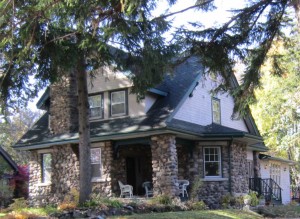 Councillor Dennison’s Lakeshore Road residence which has been designated as a heritage property is the subject of an Ontario Municipal Board hearing on whether or not the Councillor can seek a severance. Aldershot doesn’t appear to have a population that uses bikes, cycling isn’t the sport of choice for Councillor Taylor and Councillor Meed Ward, who has been seen on a bike prefers walking tours of her ward. She didn’t get any money for that. Aldershot will have a walking tour – its third – for which the Council member got $500.
The delivering of these little news items is done in a friendly easy going matter. The council meeting is broadcast live via Cogeco television – the hope being that the voters will see what they are paying for in terms of elected talent.
Ward 4 Councillor Jack Dennison either chose not to inform his voters that his long delayed Ontario Municipal Board hearing starts on Tuesday and is scheduled to last for four days.
 Councillor Jack Dennison tends to stick to his guns on an issue that impacts his personal interests. The need for a four day OMB hearing will cost the city a considerable amount of money. This is the hearing that has the ward Councillor fighting a city zoning and Official Plan so that he can sever part of his property on Lakeshore Road and build an additional dwelling.
The event is a don’t miss for many of the Roseland residents – they didn’t need to be told.
Councillor Dennison apparently didn’t want the rest of his ward to know where he was going to be for the rest of the week.
The hearing takes place at city hall

 By Staff By Staff
April 20, 2014
BURLINGTON, ON
Dozens of groups spent last week thanking their volunteers – the city would not be the place it is without those volunteers.
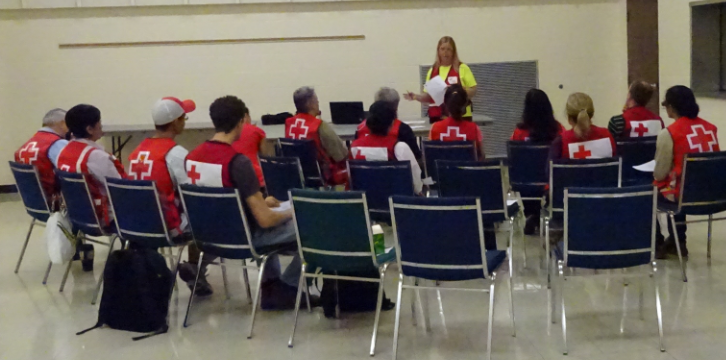 Red Cross volunteers being taken through the routines they were to follow during their door-to-door work during the flood last August. Sometimes the large organizations that have been around for more than a century get forgotten – the Canadian Red Cross is one of them
During the flooding last August it was the Red Cross that did much of the door to door work and learning where the flood damage was worst and passing that information along to the people that were doing the fixing up.
Throughout the year, volunteers from across the country, generously donate their time to improving the lives of the most vulnerable individuals and communities. “Not only this week, but each and every day, the Canadian Red Cross is sincerely thankful for the vast network of volunteers who are an integral part of this Society,” says Azima Vadsaria, Disaster Management Advisor for Halton, Hamilton and Niagara. “They are the reason we are able to make such a significant impact on those in need.”
The Red Cross has more than 20,000 volunteers nationally playing a critical role in contributing to all programs and services offered by the Red Cross.
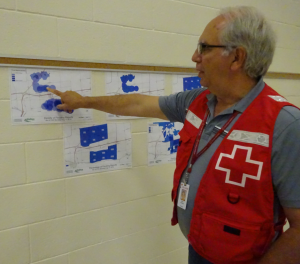 Peter Hodgson, a retired police Staff Sergeant pointing out where the damage was in a specific part of the city during the flood last August. More than 244 of those volunteers from across Halton and the province came together in Burlington to help those who had suffered devastating damage to their homes from the August 4th flood. In addition, volunteers delivered thousands of Meals on Wheels in Burlington, provided thousands of rides to medical appointments across the Region, and helped families that were forced from their homes by fires and other personal disasters and worked tirelessly in the Branch offices, ensuring that all programmes worked seamlessly.
 Helping out during the flood involved anyone with willing hands. “The passion and commitment that our volunteers carry out in their work is truly remarkable. It’s an honour to have such devoted individuals representing the work of the Red Cross from coast to coast across Canada,” added Vadsaria.

 By Staff By Staff
April 20, 2015
BURLINGTON, ON
We see it every summer – police reports of break-ins and theft of property during the day when people are at work – or out of the house.
 There was a report last year of a house being illegally entered at the front while the owners were in the back yard gardening. There was a report last year of a house being illegally entered at the front while the owners were in the back yard gardening.
Burlington is fortunate in that most people are quite vigilant and call 911 when they see something suspicious.
However, all too often the people making the phone call don’t have some of the information the police need.
Halton Regional Police Service recently put out a convenient form that they encourage people to use and stick up on the fridge.
You can print out this story and crate you own list of neighbours.
The police ask:
Do you know the first name of at least five (5) different neighbours?
Would you be able to tell police the address of the house behind you in the event you witnessed a break and enter?
Does your back door neighbour know your address?
If you answered ‘no’ to any of these questions, use the chart below and get to know your neighbours. And call 9-1-1 to report crimes in progress.


 By Staff By Staff
April 20, 2015
BURLINGTON, ON
If we are taught young enough – the lessons are usually learned for life.
 Young girls learn about the world they inhabit and get ready to learn what Burlington does every year during the BurlingtonGreen CleanUp GreenUp campaign – this Saturday. Last week the 24th Burlington Sparks and the 37th Burlington Brownies gathered at Rolling Meadows Public School for their introduction to keep the city we live in cleaner.
 Making their mark on the world they are going to grow up in.  Paying attention to detail. This Saturday, groups from around the city will be out gathering trash and tidying up after people who were less considerate.
Why so many tires end up in the creeks and ravines is hard to understand – but they are there.

|
|
 By Staff
By Staff























 Isn’t that exactly what the updated provincial sex-ed curriculum is trying to do? Spock has his detractors but there have been scores of pedagogical disciples who mostly followed in his footsteps and adhered to his general principles. And after a couple of generations it is hard to criticize what we have grown to know and appreciate.
Isn’t that exactly what the updated provincial sex-ed curriculum is trying to do? Spock has his detractors but there have been scores of pedagogical disciples who mostly followed in his footsteps and adhered to his general principles. And after a couple of generations it is hard to criticize what we have grown to know and appreciate.
 Ray Rivers writes weekly on both federal and provincial politics, applying his more than 25 years as a federal bureaucrat to his thinking. Rivers was a candidate for provincial office in Burlington where he ran as a Liberal against Cam Jackson in 1995, the year Mike Harris and the Common Sense Revolution swept the province.
Ray Rivers writes weekly on both federal and provincial politics, applying his more than 25 years as a federal bureaucrat to his thinking. Rivers was a candidate for provincial office in Burlington where he ran as a Liberal against Cam Jackson in 1995, the year Mike Harris and the Common Sense Revolution swept the province. 














 What became clear quite early is that the development of the Strategic Plan and the completion of the Official Plan are being done hand in hand – each is going to inform the other.
What became clear quite early is that the development of the Strategic Plan and the completion of the Official Plan are being done hand in hand – each is going to inform the other.

















 Spread the word. Arts and culture are important.
Spread the word. Arts and culture are important.





 Mayor Goldring clearly knows when he is on a roll – the interest in what he has to say about intensification has filled all the seats at the Performing Arts Centre on April 28th – so there will be a second performance on Thursday, May 28, 2015 at 7 p.m. at Tansley Woods Community Centre, 1996 Itabashi Way. Admission is free. Registration is requested by calling 905-335-7607 or emailing mayor@burlington.ca.
Mayor Goldring clearly knows when he is on a roll – the interest in what he has to say about intensification has filled all the seats at the Performing Arts Centre on April 28th – so there will be a second performance on Thursday, May 28, 2015 at 7 p.m. at Tansley Woods Community Centre, 1996 Itabashi Way. Admission is free. Registration is requested by calling 905-335-7607 or emailing mayor@burlington.ca.

 There are parts of the city where any form of intensification is not going to get past the first sentence. The backlash in some communities will be so strong that the Mayor, and every member of this Council, will quickly move on to a subject that leaves smiles on the faces of the voters.
There are parts of the city where any form of intensification is not going to get past the first sentence. The backlash in some communities will be so strong that the Mayor, and every member of this Council, will quickly move on to a subject that leaves smiles on the faces of the voters.
 As the city’s largest volunteer participation action event, Community Clean Up Green Up Day is an important (and fun) opportunity for citizens, community groups, schools, and businesses to come together, make a difference for our environment and take pride in our city by cleaning it up.
As the city’s largest volunteer participation action event, Community Clean Up Green Up Day is an important (and fun) opportunity for citizens, community groups, schools, and businesses to come together, make a difference for our environment and take pride in our city by cleaning it up.





 There was a report last year of a house being illegally entered at the front while the owners were in the back yard gardening.
There was a report last year of a house being illegally entered at the front while the owners were in the back yard gardening.







